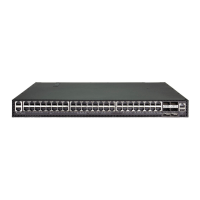C
HAPTER
10
| Class of Service
Layer 3/4 Priority Settings
– 280 –
◆ If a packet arrives with a 802.1Q header but it is not an IP packet, then
the CoS/CFI-to-PHB/Drop Precedence mapping table is used to
generate priority and drop precedence values for internal processing.
Note that priority tags in the original packet are not modified by this
command.
◆ The internal DSCP consists of three bits for per-hop behavior (PHB)
which determines the queue to which a packet is sent; and two bits for
drop precedence (namely color) which is used by Random Early Discard
(RED) to control traffic congestion.
◆ Random Tail Drop is supported for the queue descriptors and buffers
only. When Random Tail Drop is enabled, the last six bits of the queue
descriptor limit and buffer limits are randomized. This allows a
simplified Random Early Discard (RED) and breaks queue
synchronization when the queue is congested due to different sources
sending packets with the same byte count.
PARAMETERS
These parameters are displayed:
◆ Port – Specifies a port.
◆ CoS – CoS value in ingress packets. (Range: 0-7)
◆ CFI – Canonical Format Indicator. Set to this parameter to “0” to
indicate that the MAC address information carried in the frame is in
canonical format. (Range: 0-1)
◆ PHB – Per-hop behavior, or the priority used for this router hop.
(Range: 0-7)
◆ Drop Precedence – Drop precedence used for Random Early Discard
in controlling traffic congestion. (Range: 0 - Green, 3 - Yellow, 1 - Red)
Table 18: Default Mapping of CoS/CFI to Internal PHB/Drop Precedence
CFI
CoS
0 1
0(0,0)(0,0)
1(1,0)(1,0)
2(2,0)(2,0)
3(3,0)(3,0)
4(4,0)(4,0)
5(5,0)(5,0)
6(6,0)(6,0)
7(7,0)(7,0)

